
Medieval Sermon Studies
Scope & Guideline
Advancing Scholarship in Medieval Sermon Literature
Introduction
Aims and Scopes
- Historical Analysis of Sermons:
The journal emphasizes the historical context of medieval sermons, examining how sermons reflected and shaped the beliefs and practices of the time. - Thematic Exploration of Preaching:
It investigates key themes in medieval sermons, such as conversion, morality, and the role of saints, contributing to an understanding of medieval spirituality. - Interdisciplinary Approaches:
The journal employs interdisciplinary methodologies, incorporating insights from history, literature, theology, and art to enrich the study of medieval sermons. - Cultural Interactions:
There is a focus on the interactions between different cultures and religions, particularly in relation to preaching and its impact on community identities. - Exempla and Rhetoric:
The use of exempla (moral anecdotes) and rhetorical strategies in sermons is a key area of study, highlighting the persuasive techniques employed by medieval preachers.
Trending and Emerging
- Preaching and Conversion:
The theme of conversion, particularly in the context of late medieval preaching, has gained prominence, highlighting its psychological and social dimensions in the medieval experience. - Interfaith Encounters and Dialogues:
Recent studies increasingly explore the interactions between Christian, Jewish, and Muslim preaching, reflecting contemporary scholarly interest in interfaith dialogue and cultural exchanges. - Visual Culture and Preaching:
The incorporation of visual imagery in preaching, especially Marian imagery, indicates a growing recognition of the role of visual culture in religious instruction and its psychological impact. - Rhetoric and Persuasion Techniques:
Analyzing the rhetorical strategies employed in sermons has become a focal point, revealing how preachers crafted their messages to resonate with their audiences effectively. - Numeracy and Spiritual Calculations:
The exploration of numeracy and its significance in late medieval sermons represents a unique intersection of theology and mathematics, showcasing the intellectual currents of the time.
Declining or Waning
- Focus on Traditional Saints' Sermons:
There has been a noticeable decrease in studies centered on traditional sermons about well-known saints, suggesting a shift towards more diverse and lesser-known figures. - Medieval Legal and Canonical Preaching:
Research on the intersection of preaching and legal frameworks, such as canon law, is less prominent, indicating a potential waning interest in this aspect of sermon studies. - Exclusively Latin Sermons:
The focus on Latin sermons alone has diminished, as there is a growing interest in vernacular sermons and their role in medieval society. - Sermons in Isolated Geographical Contexts:
Studies concentrating solely on isolated geographical contexts are less frequent, as scholars increasingly adopt comparative approaches that encompass broader regions and cultures.
Similar Journals

Revista Chilena de Estudios Medievales
Cultivating a Global Dialogue on Medieval HeritageRevista Chilena de Estudios Medievales, published by Universidad Gabriela Mistral, is a premier open access journal that has been serving the field of medieval studies since 2012. With its unique ISSN 0719-2215 and E-ISSN 0719-689X, this journal provides a vital platform for scholars, researchers, and students interested in the rich tapestry of medieval history, literature, and culture. Located in Santiago, Chile, at Ladislao Errazuriz 2073, Providencia, Santiago 00000, the journal aims to foster a deeper understanding of the medieval period through interdisciplinary research and insightful articles. While impact factors and HIndex data are currently unavailable, the journal is dedicated to maintaining high academic standards and promoting knowledge dissemination in the field. Its open access model ensures that research is freely available to the global community, thereby enhancing engagement and collaboration among medieval studies scholars. Join us in exploring the depths of the medieval world through Revista Chilena de Estudios Medievales.
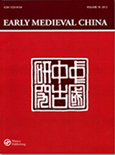
Early Medieval China
Bridging Disciplines to Reveal Early Medieval ChinaEarly Medieval China is a distinguished journal published by ROUTLEDGE JOURNALS, TAYLOR & FRANCIS LTD, specializing in the intricate study of early medieval China through an interdisciplinary lens that encompasses Anthropology, Cultural Studies, History, Literature and Literary Theory, Philosophy, and Religious Studies. With a commendable impact factor and a prestigious standing in various quartile rankings, such as Q1 in Literature and Literary Theory and Q2 in Cultural Studies and History for 2023, this journal serves as a vital resource for scholars, researchers, and students alike. It aims to promote a deeper understanding of China's early medieval period by publishing innovative research, critical essays, and comprehensive analyses that contribute to the broader discourse on Asian studies and history. By offering a platform for cutting-edge research, Early Medieval China plays an essential role in enriching academic dialogue and fostering further explorations in this historically significant field.

Medievalismo
Cultivating Knowledge of the Medieval WorldMedievalismo is a distinguished academic journal dedicated to the interdisciplinary study of medieval culture, history, and societal influences, published by the esteemed University of Murcia in Spain. Since achieving Open Access in 2010, it has fostered a rich environment for the dissemination of knowledge, encouraging contributions from researchers and scholars across diverse fields. The journal holds a notable Q1 ranking in History and exhibits strong performance metrics in Arts and Humanities and Cultural Studies, as evidenced by its relevant Scopus rankings. With a commitment to promoting high-quality research and discussion, Medievalismo has positioned itself as an essential resource for academics and students aiming to deepen their understanding of the medieval period. Situated in a vibrant scholarly landscape, it continues to publish transformative insights and foster critical dialogue, making significant contributions to the cultural and historical narratives of our time.
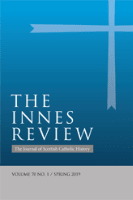
Innes Review
Uncovering insights that shape our understanding of the humanities.The Innes Review is a distinguished academic journal published by Edinburgh University Press, focusing on the study of culture, history, and religion. With a commitment to advancing scholarly discourse, the journal serves as an essential resource for researchers and professionals alike, providing critical insights and analyses that cater to the diverse interests within Cultural Studies, History, and Religious Studies. Established in 1996 and continuing through 2024, the journal has achieved notable recognition, reflecting its contributions through its Q3 ranking in History and Q4 rankings in Cultural and Religious Studies according to the latest metrics. While it currently operates without an open access model, the Innes Review remains accessible through a variety of academic databases and resources, underpinned by rigorous peer-review processes that ensure high-quality publications. As such, it stands as a vital platform for disseminating innovative research and fostering intellectual engagement within the humanities.
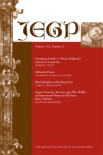
JOURNAL OF ENGLISH AND GERMANIC PHILOLOGY
Fostering Interdisciplinary Dialogue in LinguisticsJournal of English and Germanic Philology, published by University of Illinois Press, stands as a prestigious forum for scholarly discourse in the fields of linguistics and literary studies. With its ISSN 0363-6941 and an impressive impact factor aligning it within the Q1 and Q2 quartiles in key academic categories, this journal delves into nuanced explorations of both the English and Germanic languages, enriching the understanding of language and its literary frameworks. The journal aims to foster interdisciplinary dialogue, offering cutting-edge research that appeals not only to linguists and literary theorists but also to educators and cultural historians alike. Although the journal is not open access, its contributions are essential for anyone keen on enhancing their knowledge of linguistic phenomena and literary narratives from these influential linguistic traditions. With a commitment to publishing innovative and rigorous scholarship, the Journal of English and Germanic Philology is a vital resource for academics seeking to advance their work in language and literature.
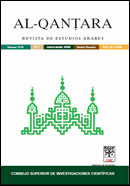
AL-QANTARA
Connecting Past and Present Through Scholarly Excellence.AL-QANTARA, published by the Consejo Superior Investigaciones Cientificas (CSIC), is a prestigious academic journal that has been at the forefront of interdisciplinary research in the fields of Cultural Studies, History, and Literature and Literary Theory since its inception in 1984. Renowned for its commitment to open access since 1996, the journal promotes a comprehensive understanding of the interconnectedness of cultural narratives and historical discourse, making it an invaluable resource for researchers and students alike. With impressive rankings in Scopus—including a top placement in the Q1 category for Literature and Literary Theory and Q2 in both Cultural Studies and History—AL-QANTARA effectively bridges theoretical insights with empirical research, contributing to robust academic dialogue and innovation. Operating out of Madrid, Spain, it stands as a pillar of scholarly excellence, offering a platform for diverse voices in the humanities to share their findings and engage with critical contemporary issues.

Listy Filologicke
Connecting Disciplines: Where History Meets Linguistics and Literature.Listy Filologicke is a distinguished academic journal published by the Institute of Classical Studies at the Academy of Sciences of the Czech Republic, focusing on the interdisciplinary fields of History, Linguistics and Language, and Literature and Literary Theory. With an ISSN of 0024-4457 and an E-ISSN of 2570-9410, this journal has been a pivotal platform for scholarly discourse since its convergence years began in 2003. Notably, it holds a Q3 classification in History and Linguistics and Language, and a Q2 in Literature and Literary Theory as of 2023. Its rankings within Scopus illustrate its relevance and impact in academia, with noteworthy positions in the Arts and Humanities and Social Sciences categories. Researchers, professionals, and students will find Listy Filologicke an invaluable resource for exploring cutting-edge research, critical analyses, and discourse that contribute significantly to their respective fields. Based in the heart of the Czech Republic, it continues to promote scholarly excellence and foster international collaboration.
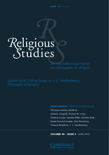
RELIGIOUS STUDIES
Advancing Scholarly Dialogue on Spiritual TraditionsRELIGIOUS STUDIES, published by Cambridge University Press, is a prestigious journal dedicated to the exploration of diverse religious traditions and philosophical inquiries. With an ISSN of 0034-4125 and an E-ISSN of 1469-901X, this journal has established itself as a pivotal platform for scholarly dialogue since its inception in 1965, continuing its impactful contributions until 2024. The journal is ranked in the top quartile (Q1) in both Philosophy and Religious Studies, illustrating its significant standing within the academic community; it holds an impressive Scopus rank of #64 in Religious Studies and #180 in Philosophy, placing it in the 90th and 77th percentiles respectively. Though not open access, RELIGIOUS STUDIES offers critical insights and original research that address contemporary issues in spirituality, ethics, and interreligious dialogue, making it an essential resource for researchers, professionals, and students alike seeking to deepen their understanding of the complex interplay between religion and society.

Zbornik Radova Vizantoloskog Instituta
Exploring the Rich Tapestry of Byzantine StudiesZbornik Radova Vizantoloskog Instituta is a distinguished open-access journal published by the Institute of Byzantine Studies, Serbian Academy of Sciences and Arts, located in Belgrade, Serbia. Since its inception in 2003, this journal has served as a vital platform for the dissemination of scholarly research in the fields of Classics, History, Linguistics and Language, and Literature and Literary Theory. Although it currently holds a Q4 ranking in the 2023 category quartiles, its commitment to fostering academic discourse and research accessibility is unwavering. The journal features a diverse range of articles that explore the complexities and nuances of Byzantine studies and related disciplines, catering to a broad audience of researchers, professionals, and students dedicated to the humanities. With a focus on both historical context and contemporary perspectives, Zbornik Radova Vizantoloskog Instituta aims to contribute significant insights into the academic community while promoting scholarly interaction on a global scale.

Imago Temporis-Medium Aevum
Cultivating a Rich Understanding of the Middle AgesImago Temporis-Medium Aevum is a distinguished journal published by SPACE POWER & CULTURE- CONSOLIDATED MEDIEVAL STUDIES RESEARCH GROUP, focusing on the rich tapestry of medieval studies within the context of history. Based in the culturally vibrant region of Catalonia, Spain, this journal has established itself as a vital resource for scholars and enthusiasts alike since it adopted an Open Access model in 2007, ensuring that its compelling research is widely accessible. With an impact factor reflected in its Q3 category ranking in the field of History for 2023, and an impressive Scopus rank in the 62nd percentile amongst 1,760 publications, Imago Temporis continues to serve as an incubator for innovative scholarship. The journal's consistent publication history, particularly from 2011 to 2013, 2016 to 2018, and its ongoing commitment through 2024, underscores its dedication to advancing the understanding of the medieval era. Researchers, students, and professionals are encouraged to engage with its unique content, which is poised to challenge traditional perspectives and contribute to the global discourse in medieval studies.